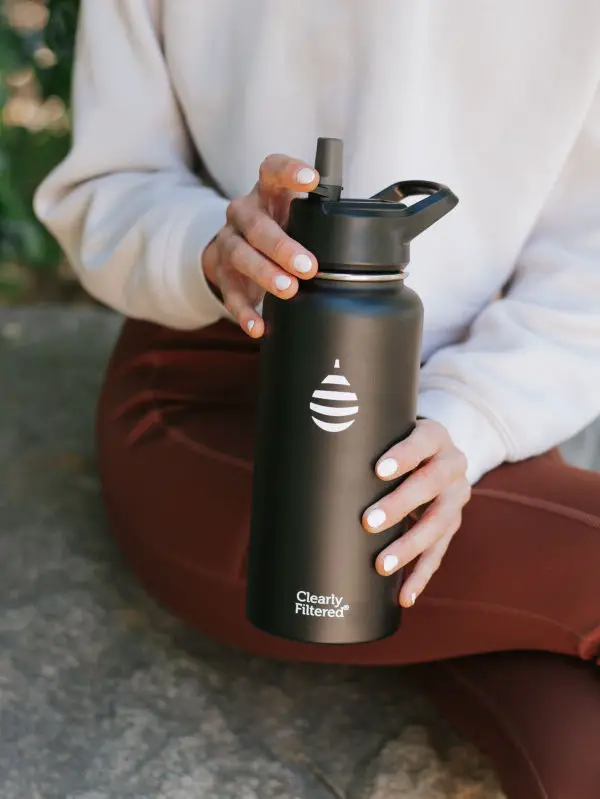Water flavorings without artificial food coloring typically rely on natural colors to add vibrancy to their products. Natural coloring is normally sourced from fruit and vegetable juices and is a healthy alternative.
We often hear to eat the colors of the rainbow, but are food colorings and dyes the exception? Recent research found more than 40% of products in a grocery store contained artificial food coloring, which we know can be harmful. But are healthy alternatives, such as water flavorings without food coloring, readily available?
Fortunately, brands without food coloring do exist, including water flavorings – and we found 7 of them!
Food Coloring in our drinks
Food coloring, also known as a color additive or food dye, is a type of food additive designed to enhance the color and appearance of a food. Color additives are also added to beverages, medications, supplements, and cosmetics.
Many types of food colorings exist, including artificial coloring and natural coloring. Because natural food colorings are regarded as safe, this article will focus on artificial food coloring.
Common Artificial Food Dyes
Currently, there are nine certified color additives approved by the Food and Drug Administration (FDA). These include:
- FD&C Blue No. 1
- FD&C Blue No. 2
- FD&C Green No. 3
- Orange B
- Citrus Red No. 2
- FD&C Red No. 3
- FD&C Red No. 40
- FD&C Yellow No. 5
- FD&C Yellow No. 6
Certified color additives are synthetic colorings that must undergo certification whenever a new batch is produced. “Exempt” color additives are produced from natural sources and still must be approved by the FDA. Although they are not subject to batch certifications like certified color additives.
Benefits & Risks of Food Coloring
The primary benefit of artificial and natural food coloring is enhancing the appearance and desirability of a food. Color additives also help separate flavored products such as purple for grape, blue for blueberry, etc.
In terms of artificial food coloring, the safety concerns often outweigh the benefit of coloring a food product. In fact, a 2019 review suggests consuming artificial dyes causes genotoxic (gene damage) and carcinogenic (cancer-causing) effects that may lead to the development of:
- Asthma and bronchitis
- Eczema
- Headache
- Reduced blood coagulation (clotting)
Aside from these risks, the most common concern about artificial food colors relates to children’s health.
Despite mixed results, some studies raise concerns regarding the effect of artificial food colorings on child behavior. More specifically, artificial food colorings and their role in exacerbating attention deficit and hyperactivity disorder symptoms.
To add, foods injected with artificial food coloring also tend to be ultra-processed and lack nutritional value. They are laden with refined sugar, flour, and oil and increase the risk of health conditions such as obesity, type 2 diabetes, and heart disease.
To avoid water flavorings with artificial sweeteners, read this post.
How to Find Artificial Food Coloring In Products
The FDA indicates artificial food coloring use increased more than fivefold between 1950 and 2012, from 12 to 68 milligrams (mg) per capita per day.
So, how do you know if products contain artificial food coloring? Use these tips to find out if artificial dyes have been added:
- If the product is more vibrant than anticipated. Seeing color even at a quick glance can be a telling sign food coloring has been added. However, the color added could either be natural or artificial and requires deeper investigation.
- Read the Ingredients label, as the FDA requires food manufacturers to list all ingredients on the label. The label must list the names of any FDA-certified color additive such as FD&C Blue No. 1 or its abbreviated name (Blue 1). “Artificial colors,” “artificial color added,” “color added,” or equally informative terms might indicate an exempt color has been added.
- Double-check the brand’s various product options, as some brands might offer both artificial and all-natural products.
- If still unsure if the product contains artificial food coloring, reach out and ask the product’s customer service team.
Also when in doubt, sip sit it out! Instead, go for more natural products like plain H20 or water flavorings without food coloring.
Brands of Water Flavoring Without Food Coloring
The potential risks of artificial food coloring have influenced consumers to seek out and purchase a more natural alternative.
Such a push has even persuaded food companies to offer more natural products, including these brands of water flavoring without food coloring, and are readily available from Amazon.
1. Stur Liquid Water Enhancer
Stur liquid water enhancers are naturally colored with fruit and vegetable juices. These thirst-quenching flavors are also naturally flavored and sweetened with natural fruit flavor and Stevia extracts.
Pros:
- Naturally colored and flavored
- Various flavor options, including fruit punch, lemonade, blue and blackberry, pomegranate cranberry, strawberry watermelon, and coconut pineapple
- Conveniently makes 100, 8-oz flavored water drinks
- Satisfaction Guarantee
- Diverse application suggestions, including sparkling water, smoothies, and yogurt
Cons:
- Some complaints of weak flavor and unpleasant aftertaste
2. Sweet Leaf Liquid Stevia
SweetLeaf’s liquid stevia is free of artificial food dyes and flavored and sweetened with natural ingredients, including organic stevia leaf extract. Choose from an extensive variety of natural flavors, including cinnamon, chocolate raspberry, coconut, pumpkin spice, lemon, berry, and more!
Aside from flavoring your drink, use the drops to enhance oatmeal, yogurt, and so much more – all without the unwanted sugars and calories!
Pros:
- All flavors contain natural ingredients
- Versatile use
- Zero calories or carbs
- Non-glycemic response to avoid blood sugar fluctuations
- Free of gluten, GMOs, citric acid, potassium, and caffeine
Cons:
- Greater spill risk due to two-piece twist off droplet top
- Glass bottle might be easier to break
3. Hydrate Electrolyte Liquid Drink Enhancer Drops
Hydrate electrolyte liquid drink enhancer drops offer a sweet mixed berry flavor without artificial food coloring and other ingredients. Supplying quick-dissolving electrolytes and B vitamins, the liquid enhancer drops are great for athletes and health enthusiasts on the go.
Pros:
- Free of artificial food coloring
- Supplies and replenishes essential electrolytes, especially when lost in sweat
- Quickly dissolves (unlike most powdered electrolytes)
- Compact size to replace bulk sports drinks
Cons:
- Overconsuming electrolytes can cause unpleasant side effects, including dizziness, muscle weakness, and vomiting
- Weak taste according to some consumers
4. SweetLeaf WaterDrops
SweetLeaf’s WaterDrops are free of artificial ingredients, as well as calories, carbs, and caffeine. They also offer a wide variety of fruity flavors, including lemon lime and strawberry kiwi, so there’s an option to suit any personal preference.
Pros:
- No artificial ingredients added
- 6 fruity flavors to choose from
- 48 servings per bottle
- Devoid of calories, carbs, GMOs, and gluten
- BPA-free squeeze bottle
Cons:
- Some flavor options are suggested to be too sweet and lack the intended flavor
5. H2wOw Water Enhancer Drops
The H2wOw water enhancer drops are flavored and colored with fruit extracts and botanical essences, so fret not about artificial ingredients. The available 4-pack features the invigorating flavors of watermelon honeydew, lime ginger, cucumber lemongrass, and lemon spearmint.
Pros:
- 100% all-natural ingredients
- Unique flavor combinations, including lime ginger, cucumber lemongrass, lemon spearmint, and watermelon honeydew
- Added mineral electrolytes to optimize hydration
Cons:
- H2wOw contains calories and a touch of sugar from agave
6. Clear Theory Water Flavoring Drops
Clear Theory water flavoring drops offer 100% transparent hydration, meaning no artificial color and no artificial ingredients. Electrolytes and zinc are also added for the ultimate hydration on the go.
Pros:
- Free of artificial coloring and ingredients, as well as caffeine, gluten, and GMOs
- Vegan and kosher-friendly
- Four flavor options, including watermelon berry, orange vanilla, blue raspberry, and fruit punch
Cons:
- Supplies 160 calories per bottle (20 calories per serving)
7. True Citrus Water Flavor Packets
With ingredients like beet powder and spirulina, True Citrus truly is all-natural! “Get real flavor from real fruit” in various natural flavors, including original limeade, watermelon limeade, strawberry lemonade, mango orangeade, and black cherry limeade.
Pros:
- Contains natural ingredients
- Various citrus flavors to choose from
- All citrus flavors free of potassium
Cons:
- Packets might not be as convenient as squeezable bottles
- Contains 10 calories per packet
Also read about brands of water flavoring without calories here.
The Best Water Filter Bottle We’ve Ever Used
Clearly Filtered | Stainless Steel Filter Bottles
We really love these filter bottles for keeping your drinks cool and contaminant free! They remove 99.9% of over 220 contaminants and use BPA-free plastics and double-walled stainless steel to produce some awesome looking designs with numerous bottle sizes for every situation. You can find them at Clearlyfiltered.com








